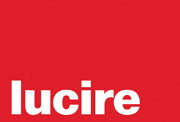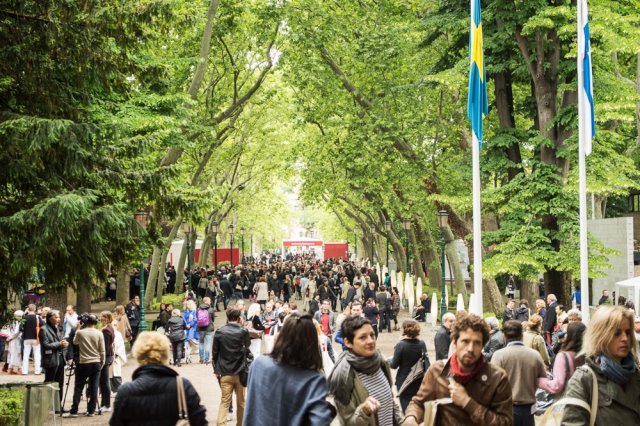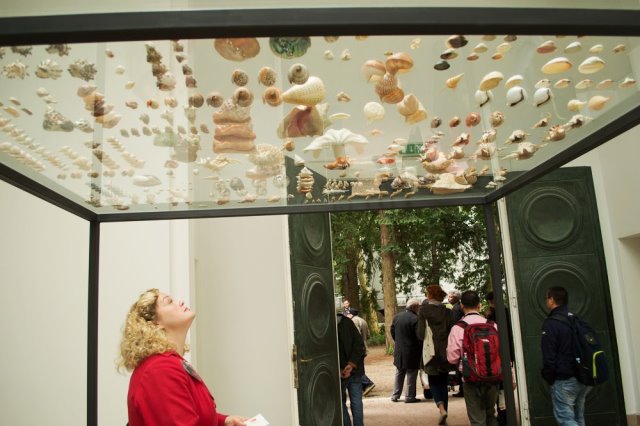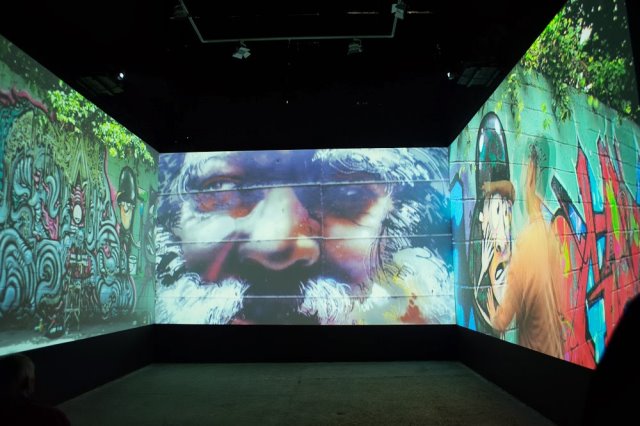
 |
July 27, 2024 Follow us |
|
|
|
Italy
Share this page |
    From top Crowds at the Giardini during preview days. The Czech pavilion. Urban art in the Venezuelan pavilion. Coffee shop for a calming experience at the Palazzo Enciclopedico. What do you think about that?Stanley Moss has alternative perspectives on previewing the Biennale di Venezia
Inarguably the world’s greatest art sideshow, 2013’s Biennale di Venezia is a triumph of media, beautifully choreographed by an expert press office. You’ve read multiple accounts of the spaces, the thoughtful and popular work, the young curator Massimiliano Gioni, and the new vision of ‘art from the inside.’ But what’s the reality of the experience, seen from the ground, factored by shoe leather and eyeballs? Begin with the scale of the event, nothing short of huge, occupying the old shipyards, the adjacent Giardini and other satellite installations. Once you’ve navigated the Arsenale entry, with its new high-security ticket scanners and jovial gatekeepers, you begin a long walk into the vast grounds, more than a kilometre in length. Wear your comfortable shoes, as you’re going to be tramping about for hours on concrete and gravel and irregular surfaces, through dark passages and narrow corridors. Be prepared to gawk: costume and spectacle figure in the mass migration of beautiful people thronging the Biennale’s lanes. You will witness high to low fashion statements, the wiggiest eyewear imaginable, exhibitionistic wannabes and ‘spontaneous’ art happenings, like the Chinese guy in the construction hat who sprawled motionless in the centre of a well populated footpath in a mysterious demonstration of something. It takes a serious time commitment to even get to the Arsenale, a vast place the insides of which most tourists never see. The preferred mode for arrival is a vaporetto ride, followed by an aerobic daylong trek of Nordic proportions. Eventually you can conquer the farthest reach of the L-shaped expanse of aligned pavilions, also the point at which serious hunger is bound to occur to you. This brings us to the first great Biennale meditation, stimulants and sustenance, certainly not art. Illy, promoting its single-portion coffee capsule machines, did an enormous public service by offering preview visitors free caffeine shots at booths surrounded by fatigued minions in need of a wake-up call. As fast as they could, red-vested baristas handed out branded liquid memes followed by water shots. A small gesture, absolutely essential, and we had not even addressed the issue of nourishment. More fascinating than many of the pavilions, eavesdropping and people-watching at the outdoor dining tables proved excellent diversion, while our designated representative navigated the mysterious food delivery system: it involved standing in one line for beverages (long wait), thence a separate line (cordoned off, long wait no. 2) for the food items, like the €8 turkey and egg sandwich from which the tacchino was removed, rendering it palatable. Far more fascinating were the multiple overheard ‘Darlings!’ and itineraries of the bad and the beautiful, with mention of Basel, Shanghai, Miami and New York tripping off everyone’s lips. Omnipresent cameras and mobile devices completed the scenario, further enriching the shareholders of Facebook, Twitter and Flickr, girdling the globe with instantaneous communiques of urgency and relevance. continued below
The loudest unspoken question concerned Ai Wei Wei sightings, and his three installations. Visits to them would have involved venturing to the most distant points of the Biennale in a single day—including a life-size navigation to Giudecca to see his illicit half-size miniature dioramas documenting his recent house arrest in the PRC. An Asian guy in a gaudy yellow silk jacket, who seemed to be everywhere, was either the real thing (dubious) or a variety of supreme networker flogging the Biennale for his own career advancement. More interesting on the Ai Wei Wei front were amateurish A4 fliers pasted everywhere about the Biennale environs in crude word-processed English, speculating on the artist’s complicity with running dog capitalist imperialists who had made him their own propaganda tool, obviously the work of secret agents-provocateurs deputized by the Chinese disinformation agency back home in Beijing. In quiet desperation, we boarded the free shuttle boat to the Giardini, a lush and verdant space filled with pavilions and multinational art hounds. Your correspondents are ex-New Yorkers, whose unofficial motto is ‘We don’t wait in line.’ Human drama proved more engaging. Long lines at the USA (great press kit contained on a blue plastic flash-drive bracelet), Great Britain (interminable line of 200 people), France (la même chose), and Korean pavilions precluded rehashing these over-reported places for you. We opted out of any exhibit with more than five warm homo sapiens standing in a queue. Notes from the less-travelled: the Czech Republic (a casual anti-installation about the logistics of owning art); Spain (marvellous heaps of industrial detritus from the abandoned island of Murano); Holland (sculptural explorations about proximity and the nature of materials); Japan (bizarre pastiche videos of multiple hairdressers co-creating coiffure in the wake of the Fukushima disaster); Finland (superb sculptural constructions of repurposed trees); Venezuela (urban art and graffiti taken to new heights). The Palazzo Enciclopedico bookstore induced serious agoraphobia. Main sponsor Swatch allowed us a welcome break at their modest installation to look at documentation of Luca Forcucci’s ambient sound piece created for its Shanghai Art Peace Hotel. continued below
By far our favourite adventure was the floating Portugal pavilion moored outside the Giardini, with its remarkable installation by Joana Vasconcelos. A Lisbon ferry covered with ceramic tiles, whose fantasy cabin was embellished with lace constructions and fairy lights, was a joyous relief and a departure from the seriousness of other places visited. The art critic for New York magazine, Jerry Saltz, recently observed that art has grown so big it cannot really be discussed. So it is with the Biennale, too vast to be seen in a single day, or perhaps even a week. Impressive management of such complexity still meant a long line outside the ladies’ bathrooms. When a woman jumped the line and slipped into the largely empty men’s bathrooms to use a private toilet cabinet, a German-speaking man angrily pounded on the door, yelling at her, ‘This is an area you are prohibited from using! What do you think about that?’ It was a question similar to what many guests of the Biennale were surely asking themselves about the great spectacle in Venezia which they had just witnessed. •
The global fashion magazine
|
|
|||||||
|
Stanley Moss is travel editor of Lucire. |
|||||||||
Copyright ©1997–2022 by JY&A Media, part of Jack Yan & Associates. All rights reserved. JY&A terms and conditions and privacy policy apply to viewing this site. All prices in US dollars except where indicated. Contact us here.